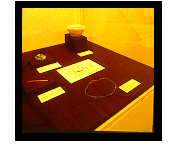![]()
 Another important category of evidence for women
and gender in ancient Egypt is archaeological materials. On a basic level,
human remains preserve the bodies of the ancient people themselves. In well-preserved
remains biological sex is usually obvious, but in other cases the determination
of sex in human skeletal remains is a complex endeavor. Once identified
as male or female, such remains can be used to help interpret gendered differences
in life expectancy, diet, disease, physical activity, and postmortem treatment.
Indeed, they are often the only direct evidence for the lives of non-elite
women and men, who left behind little or nothing in the written record,
and the only direct evidence for preliterate periods.
Another important category of evidence for women
and gender in ancient Egypt is archaeological materials. On a basic level,
human remains preserve the bodies of the ancient people themselves. In well-preserved
remains biological sex is usually obvious, but in other cases the determination
of sex in human skeletal remains is a complex endeavor. Once identified
as male or female, such remains can be used to help interpret gendered differences
in life expectancy, diet, disease, physical activity, and postmortem treatment.
Indeed, they are often the only direct evidence for the lives of non-elite
women and men, who left behind little or nothing in the written record,
and the only direct evidence for preliterate periods.
Beyond the remains of the ancient Egyptians themselves, the artifacts they left behind, when found in a controlled archaeological excavation, can afford valuable evidence for gender in terms of their context. What objects are found in the graves of only men or only women? Is there significant difference in the context of representations of males and females? In domestic contexts does the artifactual evidence suggest gendered space? Is it possible to identify gender-specific occupations from the archaeological record?
A group of artifacts found in a First Dynasty (3100-2900 BCE) burial at Gurob illustrate the problems faced by archaeologists who look for gender in human remains. The original excavators identified this burial as the grave of a woman but did not publish their reasons for doing so. They could have examined the skeletal remains for evidence of biological sex. They could also have scrutinized the grave goods for what they might reveal about the sex of the deceased. These items included a calcite bowl containing 13 pieces of raw galena (lead sulfite), an ingredient in eye paint worn by both men and women; a bone hairpin, apparently worn only by women; and a limestone bead necklace, more likely to have been worn by a woman than by a man.
![]()